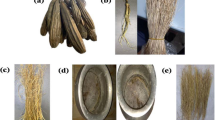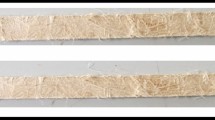Abstract
The natural plant fibers and biopolymers are a very important alternative to replace the inorganic fibers most used in the mechanical reinforcement of composite materials (carbon, glass, …) and synthetic polymers (Epoxy, PEEK, …), and at the same time they have a very low environmental impact and a very reasonable price. In this article, we have studied, by a numerical simulation based on genetic approach, the fiber-matrix interface damage of composite materials made up from the PHA (polyhydroxyalkanoates) matrix and the carbon, glass, jute, and hemp reinforcements with the same volume fraction equal to 30% for each fiber chosen. Our results showed that the damage at the fiber-matrix interface of the biocomposite hemp/PHA is the lowest compared with the other biocomposite materials glass/PHA, jute/PHA, and carbon/PHA. This finding is similar to that found by Antoine Le Duigou et al. and Bodros et al., where they have shown experimentally that the natural reinforcements greatly improve the properties of composite materials and also they have a very low environmental impact. To our knowledge, no published research reports on the study of fiber-matrix interface damage of biocomposite materials based on PHAs and carbon, glass, jute, and hemp fibers for potential textile applications, packaging, and other interesting areas.

















Similar content being viewed by others
References
C. Baley (2013) Fibres naturelles de renfort pour matériaux composites. Tecniques de l’ingénieur, vol. AM 5 130v2, pp. 1–17.
Duy Cuong Ngyen (2016) Caractérisation de l’interface fibre/matrice. Thèse de Doctorat à l’université de TROYES, Application aux composites polypropylène/chanvre
AhnParkLee WSSJSY (2001) Production of Poly(3-Hydroxybutyrate) from whey by cell recycle fed-batch culture of recombinant Escherichia Coli. Biotechnol Lett 23:235
Feliu, J. X., R. Cubarsi, and A. Villaverde (1998) Optimized release of recombinant proteins by ultrasonication of E. coli Cells. Biotechnol Bioeng 58, p 536.
Garcia LilloRodriguez-Valera JAF (1990) Effects of culture conditions on Poly(β-Hydroxybutyric acid) production by haloferax mediterranei. Appl Environ Microbiol 56:2517
Hrabak O (1992) Industrial production of Poly-β-Hydroxybutyrate. FEMS Microbiol Rev 103:251
KhannaSrivastava SAK (2005) Statistical media optimization studies for growth and PHB production by Ralstonia Eutropha. Process Biochem 40:2173
ReschGruberWannerSlaterDennisLubitz SKGSDW (1998) Aqueous release and purification of Poly(β-Hydroxybutyrate) from Escherichia Coli. J Biotechnol 65:173
SudeshAbeDoi KHY (2000) Synthesis, structure and properties of Polyhydroxyalkanoates: biological polyesters. Prog Polym Sci 25(10):1503
ZhangDengHuang LXZ (1997) Miscibility, thermal behaviour and morphological structure of Poly(3-Hydroxybutyrate) and ethyl cellulose binary blends. Polymer 38(21):5379
BugnicourtCinelliLazzeriAlvarez EPAV (2014) Polyhydroxyalkanoate (PHA): review of synthesis, characteristics, processing and potential applications in packaging. Express Polym Lett 8:791–808
LakshmanShamala KTR (2003) Enhanced biosynthesis of polyhydroxyalkanoates in a mutant strain of Rhizobium Meliloti. Biotechnol Lett 25:115–119
PadovaniCarlozziSeggianiCinelliVitoloLazzeri GPMPSA (2016) PHB-rich biomass and BioH2 production by means of photosynthetic microorganisms. Chem Eng Trans 49:55–60
Lemoigne M (1926) Produit de déshydratation et de polymérisation de l’acide béta-oxybutyrique. Bulletins de la Société de Chimie Biologique 8:770–782
Lemoigne M (1927) Etudes sur l’autolyse microbienne. Origine de l’acide 1-oxobutyrique formé par autolyse. Annales de l’Institut Pasteur (Paris) 41:148–165
ForsythHaywardRoberts WGCACJB (1958) Occurrence of poly-β-hydroxybutyric acid in aerobic gram-negative bacteria. Nature 182(4638):800–801
WallenRohwedde LLWK (1974) Poly- beta- hydroxyalkanoate from activated sludge. Environl Sci Technol 8(6):576–579
ChanVandiPrattHalleyRichardsonWerkerLaycock CML-JSPDAB (2018) Composites of wood and biodegradable thermoplastics: a review. Polym Rev 58(3):444–494
GuoTaoYangSongGengLiWangKongWang WJCCWQYMS (2012) Introduction of environmentally degradable parameters to evaluate the biodegradability of biodegradable polymers. PLoS One 7(5):e38341
Zhao H, Turng L S (2015) Mechanical performance of microcellular injection molded biocomposites from green plastics: PLA and PHBV. Biocomposites: design and mechanical performance. pp 141–160. https://doi.org/10.1016/B978-1-78242-373-7.00015-9
Silva N (2008) Etat de la connaissance scientifique sur les fibres végétales. tech. rep., FRD (Fibres Recherche Développement), Troyes.
Nardin M (2016) Interface fibre-matrice dans les materiaux composites. Revue des Compos et des Matériaux Avancés 16(1):49–62
MokaddemAlamiBoutaous AMA (2012) A study by a genetic algorithm for optimizing the arrangement of the fibers on the damage to the fiber–matrix interface of a composite material. J Text Inst 103(12):1376–1382
BenyaminaMokaddemDoumi BAB et al (2021) Study and modeling of thermomechanical properties of jute and Alfa fiber-reinforced polymer matrix hybrid biocomposite materials. Polym Bull 78:1771–1795. https://doi.org/10.1007/s00289-020-03183-7
AtigMokaddemMeskineDoumiBelkheirElkeurti KAMBMM (2019) Using genetic algorithms to study the effect of cellulose fibers ratio on the fiber-matrix interface damage of biocomposite materials. Recent Patent Mater Sci 12(1):83–90
Weibull, W (1 939) A statistical theory of the strength of materials. Royal Swedish academy of english science proceedings, 151, 1–45.
GognaKumarAnuragSahoo ERAKAP (2019) A comprehensive review on jute fiber reinforced composites. Adv Ind Prod Eng. https://doi.org/10.1007/978-981-13-6412-9_45
Ilczyszyn F (2013) Caractérisation expérimentale et numérique du comportement mécanique des agro-composites renforcés par des fibres de chanvre. Université de technologie de Troyes, Thèse de doctorat
Jacquel N et al (2007) Solubility of polyhydroxyalkanoates by experiment and thermodynamic correlations. AlChE J 53(10):2704–2714
Jacquel N et al (2008) Isolation and purification of bacterial poly(3 hydroxyalkanoates. Biochem Eng J 39(1):15–27
HwangYouDon K-JS-FT-M (2006) Disruption kinetics of bacterial cells during purification of Poly-β-Hydroxyalkanoate using ultrasonication. J Chin Inst Chem Engrs 37(3):1–8
LenzMarchessault RWRH (2005) Bacterial polyesters: biosynthesis, biodegradable plastics and biotechnology. Biomacromolecules. 6:1–8
Vincent Mathel (2016) Etude de la cristallisation du polyhydroxybutyrate. Université de Sherbrooke, (Québec) Canada.
Innocentini-MeiBartoliBaltieri LHJRRC (2003) Mechanical and thermal properties of poly(3-hydroxybutyrate) blends with starch and starch derivatives. Macromol Symp 197:77–88. https://doi.org/10.1002/masy.200350708
Shen L., Haufe J., Patel M. (2009) Product overview and market projection of emerging bio-based plastics. PRO-BIP 2009, Final report, Utrecht.
Marcel Leiner de Sá .,Érica Melo de Carvalho., Julienne Calvacante., Luis Miguel Araque., José Francisco Reis Sobrinho., Renata Barbosa (2018) Biodegradation of poly(3-hydroxybutyrate) Eggshell systems. Mat Res vol.21 no.4, 1–10. e20170792
Favre, J.-P (1992) Interface dans les composites fibreux. Techniques de l’ingénieur. Plastiques et Composites. vol. AM6, no. A7765, pp A7765.1–A7765.21.
LiPickeringFarrell YKR (2009) Determination of interfacial shear strength of white rot fungi treated hemp fibre reinforced polypropylene. Compos Sci Technol 69:1165–1171
P Ladevèse G Lubineau 2003 Pont entre micro et méso mécaniques des composites stratifies Elsevier, Composites Rendus Mécanique 331, 537–544
Lissart N (1997) Damage and failure in ceramic matrix minicomposites: experimental study and model. Acta Mater 45:1025–1044
Sébastien Grange, Jean-Loup Prensier (2006) Annexe: determination des paramètres de Weibull le modèle de Weibull: un critère de rupture probabiliste. Université Paris-Saclay, 01/07/2006 http://eduscol.education.fr/sti/si-ens-cachan/
A.Mokaddem, M.Alami, L.Temimi et A. Boutaous (2012) Study of the effect of heat stress on the damage of the fibre matrix interface of a composite material (T300/914) by means of a genetic algorithm. Fibers Text East Eur; 20, 6A(95), 108–111.
LahouariTemimiMokaddemBelkaidBouamrane HANABR (2013) Study of the effect of water intake by the matrix on the optimization of the fiber matrix interface damage for a composite material by genetic algorithms. Strength Mater 46:543–547
Cox HL (1952) The elasticity and strength of paper and other fibrous materials. Br J Appl Phys 12:72–79
Bodros E et al (2007) Could biopolymers reinforced by randomly scattered flax fibre be used in structural applications? Comp Sci Technol 67(3–4):462–470
Le Duigou A et al (2008) Effect of recycling on mechanical behavior of biocompostable flax/poly (l-lactide) composites. Comp Part A 39(9):1471–1478
LeLe DuigouKervoelenGrandNardinBaley AAAMC (2014) Interfacial properties of flax fibre–epoxy resin systems: existence of a complex interphase. Compos Sci Technol 100:152–157
Author information
Authors and Affiliations
Corresponding authors
Additional information
Publisher's Note
Springer Nature remains neutral with regard to jurisdictional claims in published maps and institutional affiliations.
Rights and permissions
About this article
Cite this article
Kaouche, N., Mebrek, M., Mokaddem, A. et al. Theoretical study of the effect of the plant and synthetic fibers on the fiber-matrix interface damage of biocomposite materials based on PHAs (polyhydroxyalkanoates) biodegradable matrix. Polym. Bull. 79, 7281–7301 (2022). https://doi.org/10.1007/s00289-021-03849-w
Received:
Revised:
Accepted:
Published:
Issue Date:
DOI: https://doi.org/10.1007/s00289-021-03849-w




